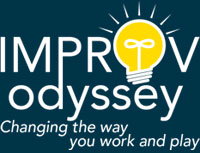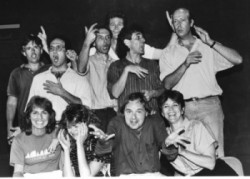Story, story…LIVE!
The game of Building a Story is a staple with improv groups around the world. It is the essence of collaboration by building a story one word at a time and by sharing ideas using give and take and intense listening.
Invariably, the challenge wakes you up and your focus becomes stronger. There are many variations of Build a Story. There’s story, one word at a time; adding sentences, continuing mid-thought and mid-word. The most popular one is interrupted storytelling, where one storyteller keeps the story going until another person is pointed at by a coach or director to continue the story. There are more variations as well. I’ve invented a few myself.
There are a lot of immediate benefits when you play Build-a-Story: You practice accepting what is given and adding to it (Yes, and…); you become part of the whole – a team; you improve listening skills and you try to keep from playwriting (being in your head). It is great fun and requires nothing more than a group of players and has great value to practice Yes, and…, good listening, and group agreement. These are all good things, but playing the game simply as an elimination game keeps the game from reaching its full potential as I see it.
By far the most popular Build-a-Story game used for performance is called Story, Story – Die! A conductor points at actors standing in a line who tell a story to the audience one word, or interrupted narrative. The story emerges and the conductor works to keep the players off-balance by pointing randomly and quickly to different players. When a player gets in their head, they hesitate and stops the flow of the story that player is eliminated; the audience is often asked to ‘boo’ the offender and that actor is asked to demonstrate their humiliation at failing by enacting a comic death. It is very entertaining, and most Improv groups never go beyond whittling it down to a winner.
It is a shame that nobody see past this to Build-a Story’s real purpose. Stopping at a winner misses the point entirely. It is a missed opportunity to develop what Build-a-Story can be.
I have a problem with the ‘die’ part of Story, Story. Playing with the ‘die’ directive does motivate players to play strongly by making winning the goal. Some players thrive on this competition and will sharpen their skill by trying to be a winner. Not winning can be seen as a failure and that is part of it too. Accepting failure without fear or self-judgement is a good lesson, but it always feels a little bad not to have won. I will admit that celebrating failure by inventing a clever death does make failing less of a negative, but it does not help the player get beyond the problem of how to stay in the game. Everyone accepts that there can be only one winner and each player strives to be the winner on their own without support. This subtly promotes the success/failure, approval/disapproval syndrome.
In not dealing with what happens when, for whatever reason, a player stops listening, hesitates or comments on the story and loses track, or tries to be funny and adds a silly non-sequitur which stops the flow of the group, an opportunity is missed to go beyond Story, Story Die! to the bigger prize – Story, Story Live!
What if you acknowledge the problem of hesitation and other resistance and find a way to solve it? How can you keep everyone in the game? What about changing the focus from winning to finding ways that work to make it possible for everyone to keep going? What if the story went on and on because everyone was playing fully involved and not focused on failing? Where could this lead?
Over the years I’ve invented variations of story building and other games to address this problem. My goal is to develop build-a-story skills in all the players. I use the game of mirror speech, reflecting the word and physicality of the teller with the rest of the players, each sharing their word so much that there is no time to allow anyone to be in their head. We practice spontaneity, pacing and flow with a game I call Build-a-Story King of the Hill. Two players do one-word story until one hesitates, laughs or stops making sense. Yes,this is an elimination game, but allows players many chances to challenge the current King of the Hill and stay in the game. It’s like tag – everyone plays until tired of it. It’s great fun. We also play one-word-at-a-time, two-words-at-a-time, three-words, four words, five words and then reverse it, getting back down to one word. This produces some interesting stories and will take care of many of the problems of hesitation and playwriting by preoccupying players with a second focus – that of counting their words.
I think the goal of Story, Story should be to see if you can keep everyone in the game, flowing with the emerging story without ever being in their head. Agreed, this is a big challenge, because we are so strongly tied to performing and either succeeding or failing. If that paradigm was eliminated, and you could keep everyone in the game playing fully, a new outcome emerges.
When I was with The Spolin Players, an accomplished group of veteran improvisers, we tried to get all the way to a spontaneous story becoming a theatrical piece. We just called it Story, Story and we practiced full involvement with the story, by doing a progression from one-word-at-a-time, to short sentences, to stopping mid-thought (keeping everyone off balance and on their toes) and finally physicalizing the story by acting it out, adding sound effects and spontaneously casting ourselves in the story as needed. Our goal was to create spontaneous Story Theater, the theatrical form Paul Sills developed as a result of his work with his mother’s (Viola Spolin) games. I will admit we always got to physicalizing and supporting the storytelling, but we never made it all the way to spontaneous, full-blown Story Theater. But getting to that point is should be the goal of Build-a-Story – a transcendent state where everyone is so involved in the same unfolding spontaneous story that they literally become the story.
To me, that is the holy grail of Improv.


